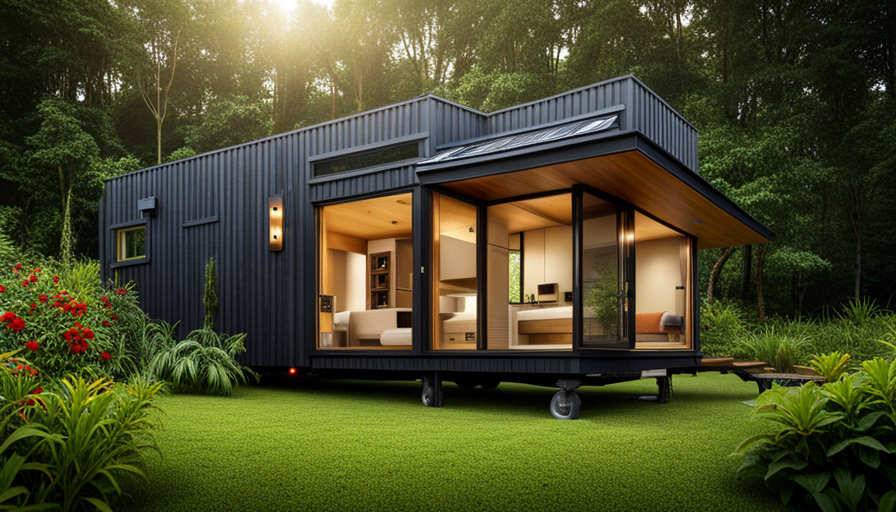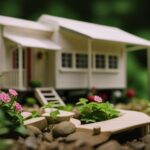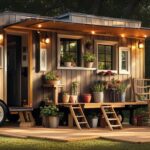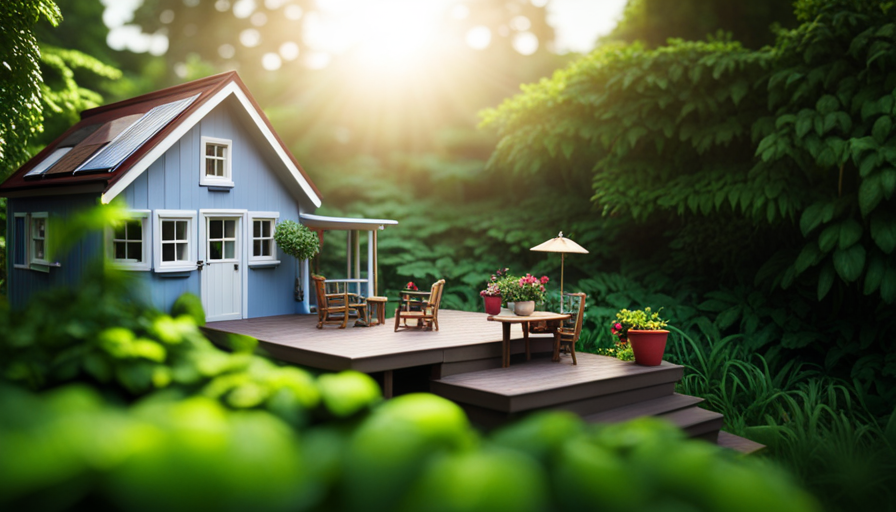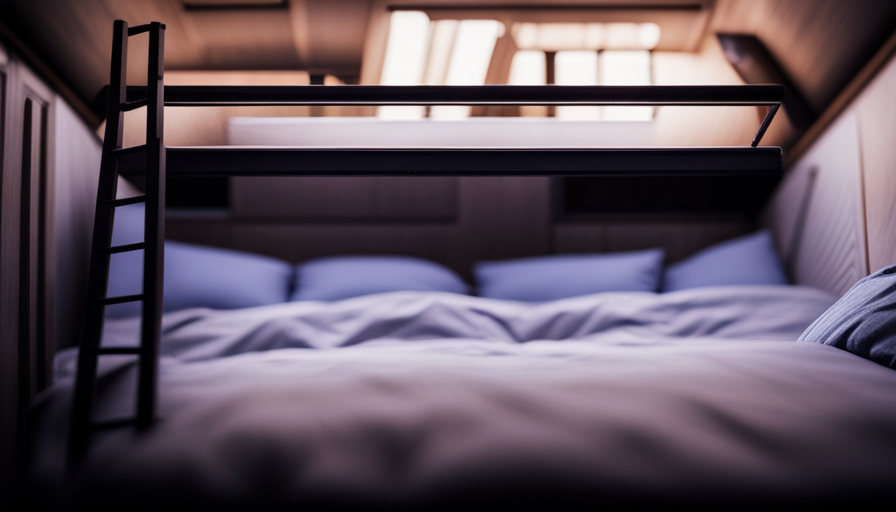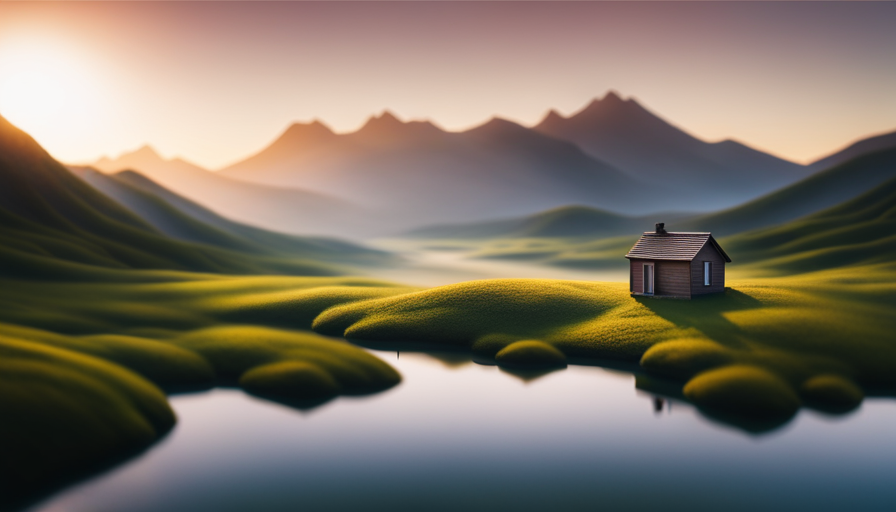Interested in constructing your own small home, are you? Fortunately, I’m available to assist you in navigating the creation of an affordable and snug haven you can call your own.
Forget about those overpriced mansions and extravagant homes, because it’s time to downsize and embrace the minimalist lifestyle.
In this article, I’ll show you how to build a cheap tiny house that doesn’t skimp on comfort or style. We’ll cover everything from determining your budget and design preferences to finding the perfect location and obtaining necessary permits.
I’ll even spill the beans on where to source affordable and sustainable materials, because who said being environmentally conscious had to break the bank?
But hold on tight, because building a tiny house requires attention to detail and precision. We’ll discuss the right foundation and structure, as well as the installation of basic utilities and systems. And of course, we can’t forget about safety and insulation – after all, you want your tiny home to be snug as a bug in a rug.
So buckle up and get ready to embark on an adventure of DIY construction. By the end of this article, you’ll be well-equipped to build your very own affordable and charming tiny house.
Let’s get started!
Key Takeaways
- Embrace a minimalist lifestyle and downsize to build a cheap and cozy tiny house.
- Pay attention to detail and precision in the building process to ensure a high-quality result.
- Choose affordable and sustainable materials for construction, considering salvaged materials, local resources, and sustainable alternatives.
- Design an efficient layout and incorporate innovative storage solutions to optimize space in a compact area.
Determine Your Budget and Design Preferences
Before you start building your cheap tiny house, it’s important to determine your budget and design preferences.
Determining the budget is the first step in the process. Take into account your financial situation and how much you’re willing to invest in this project. Consider all the costs involved, including materials, labor, permits, and any additional expenses that may arise. Research the market to get an idea of the average cost of building a tiny house, and adjust your budget accordingly.
Next, finding your design preferences is crucial. Think about the layout, style, and functionality you want for your tiny house. Consider your lifestyle and how you’ll be using the space. Look for inspiration online, visit model tiny houses if possible, and create a list of features and elements that are important to you. This will help guide you throughout the design and construction process.
Once you have determined your budget and design preferences, it’s time to find the perfect location for your tiny house. This is a crucial decision that will impact your overall experience. Consider factors such as zoning regulations, access to utilities, proximity to amenities, and the overall ambiance of the area. By carefully considering these factors, you can ensure that your tiny house will be situated in an ideal location that meets your needs and enhances your lifestyle.
Find the Perfect Location
When looking for the ideal spot, you’ll want to envision a picturesque landscape that captures the essence of your dream getaway. Finding land for your cheap tiny house can be a challenging task, but with careful planning and research, you can find the perfect location.
Consider the following factors when searching for land:
-
Zoning regulations: Check local zoning regulations to ensure that you can legally build a tiny house on the chosen land. Some areas have specific requirements or restrictions for tiny houses.
-
Accessibility: Look for a location that is easily accessible to main roads and amenities such as grocery stores, hospitals, and schools.
-
Utilities: Determine if the land has access to necessary utilities such as water, electricity, and sewage systems. If not, consider the cost and feasibility of installing these services.
-
Natural surroundings: Take into account the natural beauty of the area, such as scenic views, proximity to forests, or access to water bodies.
Finding the perfect location for your cheap tiny house is crucial to creating the ideal living environment. Once you have found the land that meets your needs and preferences, the next step is to obtain the necessary permits and licenses, ensuring a smooth and legal building process.
Obtain Necessary Permits and Licenses
To make your dream a reality, all you need to do is secure the necessary permits and licenses for your ideal location.
When it comes to building a cheap tiny house, finding cost-effective building materials is crucial. Not only will it help you save money, but it’ll also contribute to the overall sustainability of your project. Consider using reclaimed materials or exploring affordable alternatives that still meet building codes and regulations.
Streamlining the permit process is another important step in building a cheap tiny house. Research local regulations and requirements to ensure you have a thorough understanding of what’s needed. Some areas may have specific guidelines for tiny houses, so it’s essential to follow them to avoid any delays or additional expenses.
Contact your local building department to obtain the necessary permits and licenses. Provide them with detailed plans and specifications, along with any required documentation. Be prepared for inspections throughout the construction process to ensure compliance with safety standards.
By carefully navigating the permit and licensing process and using cost-effective building materials, you can build a cheap tiny house without compromising quality or safety. With the necessary permits and licenses in hand, you can now move on to the next step: choosing the right foundation and structure for your tiny house.
Choose the Right Foundation and Structure
If you want to create a solid foundation for your dream retreat, it’s time to lay the groundwork and choose the perfect anchor for your cozy oasis.
When building a cheap tiny house, it’s important to consider the various building techniques and foundation options available to ensure stability and durability. One popular foundation choice for tiny houses is the concrete slab. This involves pouring a concrete pad on level ground, providing a sturdy base for your structure.
Another option is the pier foundation, which consists of concrete piers or blocks placed at strategic points to support the weight of the house. This method is cost-effective and allows for easy leveling and adjustment.
Additionally, you can opt for a skid foundation, where the house is built on a trailer with skids that act as the foundation. This provides mobility and flexibility, allowing you to move your tiny house if desired.
Choosing the right foundation is crucial for the longevity and stability of your tiny house. With a solid foundation in place, you can now source affordable and sustainable materials for the construction of your dream retreat.
Source Affordable and Sustainable Materials
Creating a cozy oasis for your dream retreat involves finding affordable and sustainable materials that’ll bring your vision to life. When sourcing materials for your cheap tiny house, keep these affordable sourcing tips and eco-friendly material options in mind:
-
Salvaged Materials: Look for secondhand building materials such as reclaimed wood, windows, and doors. These can often be found at salvage yards, architectural salvage stores, or online marketplaces. Not only will you save money, but you’ll also give new life to materials that would’ve ended up in landfills.
-
Local Resources: Utilize materials that’re readily available in your area. This reduces transportation costs and promotes local economies. For example, consider using locally-sourced stone or clay for flooring or siding.
-
Sustainable Alternatives: Explore eco-friendly alternatives to traditional building materials. For instance, consider using bamboo instead of hardwood for flooring or countertops. Bamboo’s a fast-growing plant that’s incredibly durable and renewable.
By incorporating these affordable sourcing tips and eco-friendly materials, you can build your cheap tiny house while minimizing your environmental impact.
Now, let’s explore how to design an efficient layout and storage solutions for your compact space.
Design an Efficient Layout and Storage Solutions
In order to build a cheap tiny house, it is crucial to source affordable and sustainable materials. By doing so, you can not only reduce costs but also minimize your environmental impact. Now that we have addressed this important aspect, let’s move on to the next step: designing an efficient layout and storage solutions.
Efficient space utilization is key when it comes to tiny house design. Every square inch needs to be carefully considered and utilized to its fullest potential. To achieve this, I recommend creating a detailed floor plan that takes into account your specific needs and preferences. By doing this, you can optimize the layout and ensure that every part of your tiny house serves a purpose.
In addition to an efficient layout, innovative storage solutions are essential. Without proper storage, your tiny house can quickly become cluttered and unlivable. To maximize storage space, consider incorporating multi-functional furniture, such as beds with built-in drawers or tables with hidden compartments. Additionally, vertical storage options, like wall-mounted shelves and hanging organizers, can make the most of limited floor space.
By designing an efficient layout and implementing innovative storage solutions, you can make the most of your tiny house. Next, we will discuss how to install basic utilities and systems, ensuring your tiny house is fully functional and comfortable.
Install Basic Utilities and Systems
Now it’s time to bring your tiny oasis to life by installing the essential utilities and systems. When it comes to building a cheap tiny house, it’s crucial to consider budget-friendly plumbing options and off-grid electrical solutions.
For plumbing, you can opt for PVC pipes, which are affordable and easy to install. They’re also durable and resistant to corrosion, ensuring a long-lasting solution. Additionally, using composting toilets or low-flow toilets can help conserve water and reduce your overall water usage.
When it comes to off-grid electrical solutions, solar power is an excellent choice. Installing solar panels on the roof of your tiny house can provide you with a sustainable and cost-effective source of electricity. You can use deep-cycle batteries to store the energy generated by the solar panels, allowing you to have power even when the sun isn’t shining. LED lights are also a great choice for energy-efficient lighting in your tiny house.
With the basic utilities and systems in place, you can now move on to adding personal touches and decorations that’ll make your tiny house feel like home.
Add Personal Touches and Decorations
Transforming your cozy oasis into a personalized sanctuary is where the magic truly begins, as you infuse it with your unique style and make it a place that truly feels like home.
Here are three creative DIY projects to help you add personal touches and decorations to your tiny house:
-
Customized Wall Art: Personalize your space by creating your own wall art. Get creative with stencils, paint, or even reclaimed materials to design unique pieces that reflect your personality and style. Whether it’s a hand-painted mural or a gallery wall of your favorite photographs, customized wall art adds a personal touch to your tiny house.
-
Multi-functional Furniture: Maximize the space in your tiny house by incorporating multi-functional furniture. Look for pieces that can serve dual purposes, such as a coffee table that doubles as storage or a sofa that transforms into a bed. Not only does this optimize space, but it also adds a practical and personalized touch to your tiny home.
-
Indoor Greenery: Bring the outdoors in by incorporating indoor plants into your tiny house. From hanging planters to vertical gardens, there are numerous ways to introduce greenery and create a soothing atmosphere. Choose plants that thrive in indoor environments and fit your personal style, whether it’s vibrant succulents or lush ferns.
Personalizing your space through creative DIY projects adds character and warmth to your tiny house.
Next, we’ll explore how to ensure safety and insulation for your cozy sanctuary.
Ensure Safety and Insulation
To truly create a sanctuary that feels like home, it’s crucial to prioritize safety and insulation, ensuring a cozy and secure haven for yourself. When building a cheap tiny house, it’s important to implement safety measures to protect yourself and your belongings.
Start by installing smoke detectors and carbon monoxide detectors in strategic locations throughout the house. Additionally, consider adding fire extinguishers and a first aid kit for any emergencies that may arise.
To ensure proper insulation, there are several techniques you can employ. Start by insulating the walls, floors, and ceilings using materials such as spray foam insulation or rigid foam boards. This will help regulate the temperature inside the house and prevent energy loss. Additionally, seal any gaps or cracks with caulk or weatherstripping to prevent drafts and unwanted air leakage.
Another important aspect of insulation is properly insulating the windows and doors. Consider using double-pane windows, which provide better insulation and noise reduction. Install weatherstripping around doors to prevent air leakage and improve energy efficiency.
By implementing these safety measures and insulation techniques, you can create a cozy and secure environment in your tiny house. With a focus on safety and comfort, you can now move on to the next section and enjoy your cozy and affordable tiny house.
Enjoy Your Cozy and Affordable Tiny House
Make the most of your budget-friendly and intimate living space by finding joy in the simplicity and coziness of your tiny home. Living in a tiny house doesn’t mean compromising on comfort or style. With the right furniture and appliances, you can create a cozy and inviting atmosphere while keeping energy costs low.
To maximize the coziness of your tiny house, choose furniture that’s both functional and comfortable. Opt for multi-purpose pieces, like a sofa that can also be used as a bed or storage ottomans that double as seating. Look for space-saving solutions like foldable tables and chairs to make the most of your limited square footage.
When it comes to appliances, prioritize energy efficiency to minimize your environmental impact and reduce utility bills. Invest in energy-efficient refrigerators, washing machines, and air conditioning units. These appliances are designed to consume less energy without compromising on performance. Additionally, consider using LED light bulbs throughout your tiny house to save energy and extend their lifespan.
Creating a cozy and affordable tiny house is achievable with the right furniture and appliances. By choosing cozy furniture and energy-efficient appliances, you can enjoy a comfortable and inviting living space while keeping your budget and environmental impact in check. So embrace the simplicity and coziness of your tiny home and make it your own little haven.
Frequently Asked Questions
How much does it cost to build a tiny house?
Building a tiny house on a budget requires careful planning and cost-saving strategies. By utilizing salvaged materials, opting for a simpler design, and doing the construction yourself, you can significantly reduce the overall cost of building a tiny house.
Can I build a tiny house on any type of property?
Yes, building a tiny house is subject to building restrictions and zoning regulations. It’s important to research and comply with local laws regarding property type, size, setbacks, and other requirements before starting construction.
What permits and licenses do I need to build a tiny house?
To build a tiny house, I need to obtain permits and licenses. Building regulations and zoning requirements dictate what is allowed. It’s like navigating a maze, but with the right knowledge, I can successfully navigate the process.
What are the different types of foundations and structures I can choose for my tiny house?
There are several types of foundations and structures for tiny houses. Options include concrete slab, trailer, and post and beam. Each has its pros and cons in terms of cost, mobility, and stability.
Where can I find affordable and sustainable materials for building my tiny house?
I scoured the market and discovered a treasure trove of affordable and sustainable materials for my tiny house project. From reclaimed wood to recycled insulation, I found everything I needed to build my dream home on a budget.
Conclusion
Well, who would’ve thought that building a cheap tiny house could be so easy? With a little bit of creativity, resourcefulness, and a dash of irony, anyone can create their own cozy and affordable haven.
From determining your budget to adding personal touches, every step is an opportunity to showcase your individuality. So go ahead, tackle those permits and licenses, choose the perfect foundation, and source affordable materials.
Before you know it, you’ll be enjoying the irony of living in a tiny house that feels like a million bucks.
Hi, I’m Emma. I’m the Editor in Chief of Tiny House 43, a blog all about tiny houses. While tree houses are often associated with childhood, they can be the perfect adult retreat. They offer a cozy space to relax and unwind, surrounded by nature. And since they’re typically built on stilts or raised platforms, they offer stunning views that traditional homes simply can’t match. If you’re looking for a unique and romantic getaway, a tree house tiny house might just be the perfect option.
